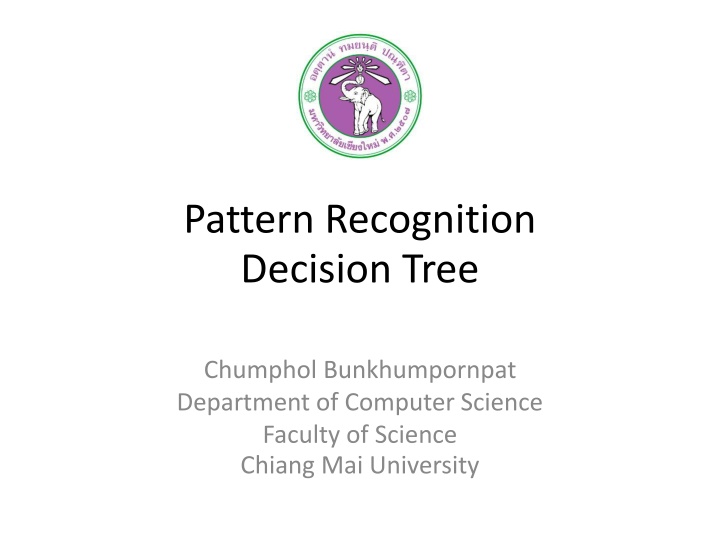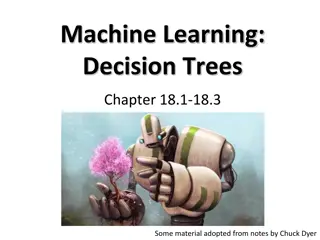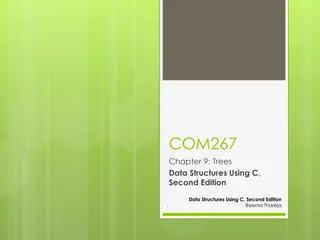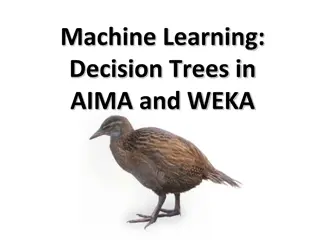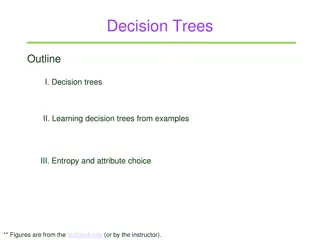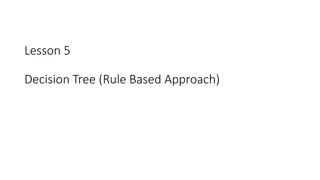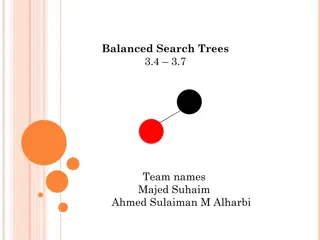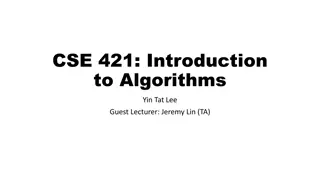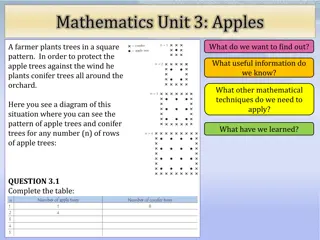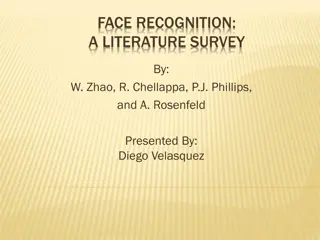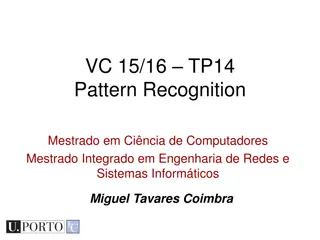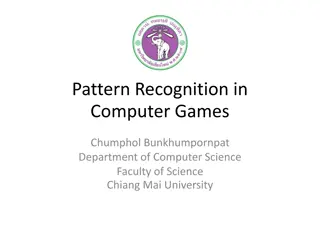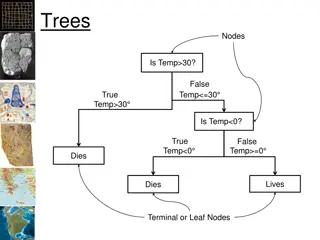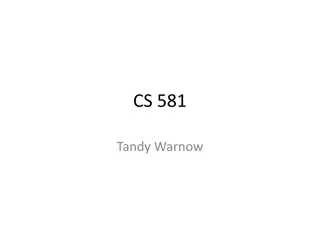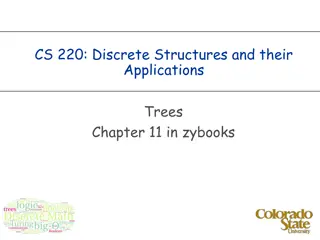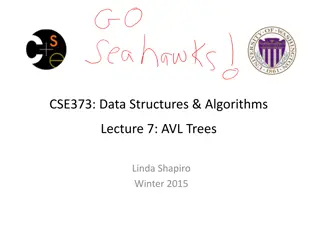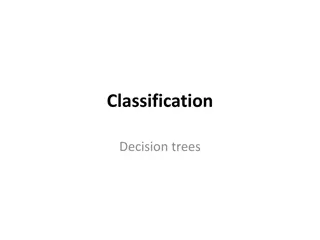Pattern Recognition and Decision Trees in Data Science
The use of decision trees in pattern recognition, classification, and decision-making processes. Learn about the strengths and weaknesses of decision trees, splitting criteria, tree induction, and the importance of tree pruning. Discover the transparency, user-friendliness, and components of decision trees, with examples illustrating their application in classification tasks."
Download Presentation

Please find below an Image/Link to download the presentation.
The content on the website is provided AS IS for your information and personal use only. It may not be sold, licensed, or shared on other websites without obtaining consent from the author.If you encounter any issues during the download, it is possible that the publisher has removed the file from their server.
You are allowed to download the files provided on this website for personal or commercial use, subject to the condition that they are used lawfully. All files are the property of their respective owners.
The content on the website is provided AS IS for your information and personal use only. It may not be sold, licensed, or shared on other websites without obtaining consent from the author.
E N D
Presentation Transcript
Pattern Recognition Decision Tree Chumphol Bunkhumpornpat Department of Computer Science Faculty of Science Chiang Mai University
Learning Objectives How decision trees are used to choose the course of action How decision trees are used for classification The strength and weakness of decision trees The splitting criterion used at the nodes What is meant by induction of decision trees Why pruning of decision tree is sometimes necessary 2 204453: Pattern Recognition
Decision Tree The most popularly used data structure Highly Transparent User-Friendly Characteristics Continuous Categorical Nominal Ordinal 3 204453: Pattern Recognition
Highly Transparent 4 204453: Pattern Recognition
Continuous Feature 5 204453: Pattern Recognition
Nominal Feature 6 204453: Pattern Recognition
Ordinal Feature 7 204453: Pattern Recognition
Decision Tree Components Internal Node Root Leaf Node Branch Mutually Distinct Collectively Exhaustive 8 204453: Pattern Recognition
Example of Decision Tree 9 204453: Pattern Recognition
Descriptions of a Set of Animals Irrelevant features do not occur in the decision tree. Sound is not needed for the discrimination of the patterns. 10 204453: Pattern Recognition
Decision Tree for Classification of Animals Root to leaf represents a rule. IF (no. of legs = 4) AND (has horns = false) AND (size = small) THEN (mouse) Classification involves making a decision at every node. Numerical Feature Classification moves down the appropriate branch till we reach a leaf node. Class labels are associated with leaf nodes. Categorical Feature 11 204453: Pattern Recognition
A set of patterns is associated with each node This set is larger at the top nodes and keeps reducing in size at subsequent levels. Decision 2 legs contains only birds and human. 12 204453: Pattern Recognition
The rule are simple Boolean function and easy to understand Single Outcome IF (no. of legs = 4) AND (has horns = false) AND (size = small) THEN (mouse) Conjunction of a number of Antecedents 13 204453: Pattern Recognition
The tree can be binary or non-binary 14 204453: Pattern Recognition
A many-way decision can be converted into a number of yes/no decisions 15 204453: Pattern Recognition
Axis-parallel Test x > a0: Height > 5 ft Hyperplane Threshold 16 204453: Pattern Recognition
Test on Linear Combination of Features : 0.4 Height + 0.3 Weight > 38 17 204453: Pattern Recognition
Test on Non-linear Combination of Features f(x) > 0 18 204453: Pattern Recognition
Non-Rectangular Decision Boundary 19 204453: Pattern Recognition
Decision Tree Performed on a Non-Rectangular Region 20 204453: Pattern Recognition
Construction of Decision Trees The most discriminative attribute is used at the earliest level in the decision tree. At each node, the set of examples is split up and each outcome is a new decision tree learning problem by itself. 21 204453: Pattern Recognition
Classification into two classes: An illustration Discriminant Feature 22 204453: Pattern Recognition
Impurity Impurity = 0 Impurity = LOW Impurity = HIGH 23 204453: Pattern Recognition
Entropy Impurity / Information Impurity Fraction of patterns at node N of category wj. 24 204453: Pattern Recognition
Node Splitting 25 204453: Pattern Recognition
Impurity Drop Njis the child node of N The attribute which maximises i(N) is to be chosen 26 204453: Pattern Recognition
Example Training Data Set for Induction of a Decision Tree 27 204453: Pattern Recognition
Cook = Sita : i(NS) = (4/4)log(4/4) = 0.0 Cook = Asha : i(NA) = (2/4)log(2/4) (2/4)log(2/4) = 1.0 Cook = Usha : i(NU) = (2/4)log(2/4) (2/4)log(2/4) = 1.0 i(N) = 0.9183 (4/12)(1.0) (4/12)(1.0) = 0.2516 -> MAX i(N) = (4/12)log(4/12) (8/12)log(8/12) = 0.9183 Mood = Bad : i(NB) = (3/6)log(3/6) (3/6)log(3/6) = 1.0 Mood = Good: i(NG) = (1/6)log(1/6) (5/6)log(5/6) = 0.65 i(N) = 0.9183 (6/12)(0.65) (6/12)(1.0) = 0.0933 Cuisine = Indian : i(NI) = (1/6)log(1/6) (5/6)log(5/6) = 0.65 Cuisine = Continental : i(NC) = (3/6)log(3/6) (3/6)log(3/6) = 1.0 i(N) = 0.9183 (6/12)(0.65) (6/12)(1.0) = 0.0933 i(NA) = 1.0 i(NS) = 0.0 Mood = Bad : i(NAB) = (2/2)log(2/2) = 0.0 Mood = Good: i(NAG) = (2/2)log(2/2) = 0.0 i(NA) = 1.0 -> MAX Cuisine = Indian : i(NAI) = (1/2)log(1/2) (1/2)log(1/2) = 1.0 Cuisine = Continental : i(NAI) = (1/2)log(1/2) (1/2)log(1/2) = 1.0 i(NA) = 1.0 (2/4)(1.0) (2/4)(1.0) = 0.0
Over-fitting Unique Root Too Specific 29 204453: Pattern Recognition
Under-fitting When model is too simple, both training and test errors are large. 31 204453: Pattern Recognition
Over-fitting Over-fitting results in decision trees that are more complex than necessary. Training error no longer provides a good estimate of how well the tree will perform on previously unseen records. 32 204453: Pattern Recognition
Algorithm for Pruning 1. Catalog all twigs in the tree 2. Count the total number of leaves in the tree 3. While the number of leaves in the tree exceeds the desired number: 1. Find the twig with the least Information Gain 2. Remove all child nodes of the twig 3. Relabel twig as a leaf 4. Update the leaf count 33 204453: Pattern Recognition
Random Forest 34 204453: Pattern Recognition
Random Forest 35 204453: Pattern Recognition
Reference Murty, M. N., Devi, V. S.: Pattern Recognition: An Algorithmic Approach (Undergraduate Topics in Computer Science). Springer (2012) https://slidetodoc.com/decision-trees-and- decision-tree-learning-philipp-krger/ https://medium.com/@witchapongdaroontha m/ 36 204453: Pattern Recognition
Logarithm Formula loga1 = 0 logaa = 1 logaab= b loga(b/c) = logab logac logab = logcb / logca 37 204453: Pattern Recognition
LightGBM Light GBM is a gradient boosting framework that uses tree-based learning algorithm. Light GBM grows tree vertically while other algorithm grows trees horizontally meaning that Light GBM grows tree leaf-wise while other algorithm grows level-wise. 38 204453: Pattern Recognition
Explains how LightGBM works 39 204453: Pattern Recognition
How other boosting algorithm works 40 204453: Pattern Recognition
Why Light GBM is gaining extreme popularity? High speed Handle the large size Takes lower memory to run Focuses on accuracy of results Supports GPU learning 41 204453: Pattern Recognition
Reference Murty, M. N., Devi, V. S.: Pattern Recognition: An Algorithmic Approach (Undergraduate Topics in Computer Science). Springer (2012) https://medium.com/@pushkarmandot/https -medium-com-pushkarmandot-what-is- lightgbm-how-to-implement-it-how-to-fine- tune-the-parameters-60347819b7fc https://arxiv.org/pdf/2210.05189.pdf 43 204453: Pattern Recognition
